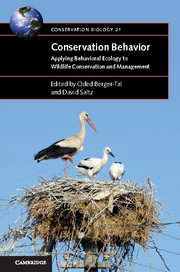Book contents
- Frontmatter
- Dedication
- Contents
- List of contributors
- Prologue
- Preface
- Acknowledgments
- Part I The integration of two disciplines: conservation and behavioral ecology
- Part II Anthropogenic impacts on animal behavior and their implications for conservation and management
- 4 Behavioral rigidity in the face of rapid anthropogenic changes
- 5 Anthropogenic impacts on behavior: the pros and cons of plasticity
- Part III Behavior-based management: using behavioral knowledge to improve conservation and management efforts
- Part IV Behavioral indicators
- Index
- References
4 - Behavioral rigidity in the face of rapid anthropogenic changes
from Part II - Anthropogenic impacts on animal behavior and their implications for conservation and management
Published online by Cambridge University Press: 05 April 2016
- Frontmatter
- Dedication
- Contents
- List of contributors
- Prologue
- Preface
- Acknowledgments
- Part I The integration of two disciplines: conservation and behavioral ecology
- Part II Anthropogenic impacts on animal behavior and their implications for conservation and management
- 4 Behavioral rigidity in the face of rapid anthropogenic changes
- 5 Anthropogenic impacts on behavior: the pros and cons of plasticity
- Part III Behavior-based management: using behavioral knowledge to improve conservation and management efforts
- Part IV Behavioral indicators
- Index
- References
Summary
WHAT IS RIGID BEHAVIOR?
For well over a century, biologists and psychologists have been arguing about the origins of behavior. Is behavior fixed and innate? Is it only determined by the genetic composition of the individual or is it flexible and shaped by the individual's environment? This heated argument, also known as the “nature versus nurture” debate, is yet unsettled (Ridley 2003), although the common consensus (at least among biologists, Bolhuis 2013) is that the dichotomy between innate and learned behaviors is false and that the development of behavior is a complex process involving continual interactions between the characteristics of an individual and its environment (Lehrman 1953).
The relevant aspect of this debate for our purposes is that some behaviors are mostly fixed, and do not change, regardless of the environment the individual is in, compared to other behaviors that are much more plastic. Furthermore, even plastic behaviors are constrained within limits, and these limits may vary depending on the behavior and the environment. We term the display of fixed behaviors in the face of a changing environment as “behavioral rigidity.” There are three main causes for behavioral rigidity: fixed or “instinctive” behaviors for which the individual displays no learning or that cannot be changed due to physical or physiological constraints, imprinted behaviors that are plastic only during the early period of an organism's life and afterwards become fixed, and behaviors that are flexible, but this flexibility is too slow to keep up with environmental change.
Fixed behaviors
Darwin was one of the first to note that behavioral and personality traits are inherited, using the hereditary nature of behavior in domesticated animals as a compelling example (Darwin 1871). What Darwin was implying, had he possessed the terminology we now have, is that many behaviors are strongly influenced and constrained by genetic factors. It was later shown that roughly 40% of the variation in personality in humans is genetic in nature (Bouchard 1994), and that animal personalities have a similarly strong genetic basis as well (van Oers et al. 2005). One of the more famous examples of such fixed behavior is the cuckoo. Despite never seeing a parent or sibling of the same species, a cuckoo individual is able to sing species-specific songs and attract fellow cuckoos as mates.
- Type
- Chapter
- Information
- Conservation BehaviorApplying Behavioral Ecology to Wildlife Conservation and Management, pp. 95 - 120Publisher: Cambridge University PressPrint publication year: 2016
References
- 6
- Cited by

